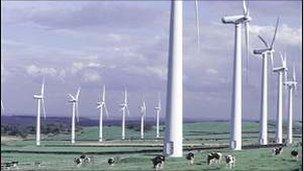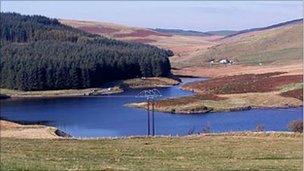A short (ish) history of wind and Wales
- Published
- comments

Wind farms: who decides, where, and how many?
This blog has talked a lot about the issue of windfarms in mid Wales in recent weeks. It's not because my surname is Powys by the way. but because it's becoming a dominant news story in this early part of the Fourth Assembly, for several reasons, some local, some national, some environmental, and some very, very political.
Forgive another stab at it that, I warn you, lives up to its title.
I bumped into the former Environment Minister Jane Davidson in Cardiff last week. She was looking happy and relaxed in her political retirement and is clearly as busy out of office as she was in it. She's comfortable in her legacy - but she has left one ticking time bomb for this new government.
A lot of heat and light (not to say electricity, geddit) is being generated by this debate, so perhaps it's worth looking back to get a bit of historical context. The ever-thoughtful Syniadau is very much worth a read here, external too.
Let's go back to the beginning - 2005 - and the now-famous Technical Advice Note 8, external itself, the TAN 8 that launched a thousand protest posters.
Its main purpose, according to the then Environment Minister Carwyn Jones, was to try and avoid a proliferation of wind farms right across Wales. So the government commissioned consultants Arup to find certain areas of the country which would be suitable for siting wind farms.
The result? The seven Strategic Search Areas were born. These were tracts of land which met certain criteria to do with wind speed and geography which made them ideal. Coded A-G, they were designed to guide planners when making decisions about windfarm applications. For smaller farms below 50MW, that would be the local planning authority, for 50MW and over, the Westminster government. The Welsh government has no say over either, unless it chooses to "call in" a decision on a farm under 50MW.
TAN 8 set out what are called "indicative capacity targets" - in other words, how much power the engineers thought could be generated in each of the seven SSAs and then a total for all seven. That total was 1120MW, or 1.12GW. This, bear in mind, was an engineer-driven figure. It wasn't the maximum or a minimum desirable or a binding figure for anyone, just a rough technical indication from the experts point of view of how many turbines each area could take.

Nant-y-Moch reservoir, near Aberystwyth
So far, so clear I hope. Pause to enjoy a shot of Nant-y-Moch reservoir.
Three of the seven SSAs are in mid Wales - B: Carno North, C: Newtown South and D: Nant-y-Moch, precisely the home of all those anti-TAN 8 posters. The indicative capacity for each was: B: 290MW C: 70MW and D: 140MW. So together they make up a fair chunk of the 1120MW total across the seven areas.
Fast forward to 2010 and the start of the National Grid's consultation, external with the people of mid Wales about the pylon network and substation needed to carry the electricity from the turbines to the grid. Only now does the penny start to drop in many areas about the scale of what's planned.
The Welsh Government has published a Review of Windfarm Developer Interest here, external, dated April 2011. It's a spreadsheet which covers the size of windfarm projects which are operational, consented, under application or scoping. Here are the totals for the three SSAs we discussed above. B: 707MW C: 429MW D: 306MW. These are, you'll have spotted, vastly in excess what was set down in TAN 8. Experts say big advances in windfarm technology, with larger and more efficient turbines means much greater capacity can be squeezed out of the same areas set down in 2005.
The total amount, operational, applied for or scoping, for the seven SSAs is 2655MW, or 2.65GW. So you can see what Carwyn Jones, now First Minister of course, was driving at last week when he said "developer interest has now greatly exceeded those indicative figures", external. Yes, it certainly has. It's up to the UK Government, he says, to rein them in and refuse applications which go beyond TAN 8.
A study from the Welsh Government from Arup in 2010 estimated that based on the current pattern of planning approvals, around 75 per cent of applications are likely to get the go ahead - unless, that is, the UK Government planners heed Carwyn Jones' plea for restraint. As we found out last week, there aren't many indications of that. That would give you a total of around 2000MW or 2GW in total - well above the 1120MW in TAN 8.
But here are a couple of relevant documents which put this into some context.

Former Environment Minister Jane Davidson
The first is a major policy statement, external from Jane Davidson as Environment Minister. Called A Low Carbon Revolution, and dated March 2010, it laid out the government's targets for renewable energy generation. The key target for the amount of onshore wind generation is 2GW by 2015-2017.
Jane Davidson's method for reaching the 2GW target was through "optimising the use" of the existing SSAs. So according to her policy, the current plans are round about on target for that. So wouldn't developers argue that their applications, far from being excessive, have been exactly in line with the government's targets?
And wouldn't Mr Jones' intervention, calling the current level of applications "unacceptable" appear to be undermining the target set during his first stint as first minister?
The second document, external has been unearthed by the Welsh Conservatives.
The Forestry Commission, back in 2005, had already warned that wind farm developments in the SSA could end up being on a larger scale than had been envisaged. In the light of Carwyn Jones' comments now, this seems pretty prescient for a document written more than six years ago.
What does this all tell us?
Well, at the very least, it seems to show an inconsistency between the approach and targets of the former Welsh Assembly Government and the new Welsh Government. What impact this will have on the decisions being made in Westminster on whether new windfarm projects will get the go ahead or not remains to be seen. The key for Ministers in Cardiff, currently, is to simply to point out very loudly that those decisions are happening in Westminster.
Glyn Davies, the MP for Montgomeryshire and parliamentary private secretary to Cheryl Gillan, wrote on his blog, external earlier this week that the "real target" for protesters should now be the Westminster Government (aka his own) rather than TAN 8 and the Welsh Government.
We shall see.